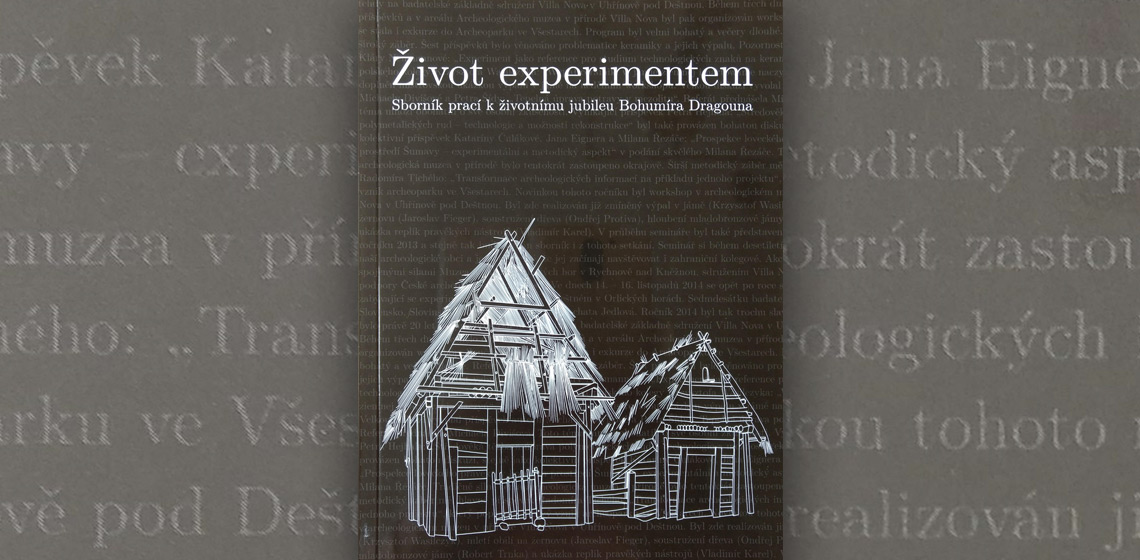
This publication was created on the occasion of the 50th anniversary of the eminent Czech archaeologist and experimenter Bohumír Dragoun. In its 168 pages the book looks at his life, and also at the increasingly popular interactive museums and experimental activities in archaeology.
The first editorial informs the reader on the importance of the publication, which is the first to attempt to map the different types of institutions dedicated to archaeological experiment in Czechia. The proceedings also contain bilingual texts – there are Polish (Archeologické muzeum v přírodě – Uhřínov pod Deštnou a Żmijowiska) and French (Les tribulations de mon ami Bohumír Dragoun chez les Gaulois Petrocores et plus spécialement chez les Beynacos) articles, with a Czech translation following immediately after and using the same graphic design.
The publication is not monothematic but it is conceived in two parts. The first part contains texts describing the origin and development of archaeoparks, archaeological open-air museums, societies and associations. The second part concentrates on experimental archaeology, which has become an attraction for both the public and experimental archaeology enthusiasts in recent years. The single contributions contain much visual material.
The foreword introduces Bohumír Dragoun and his life journey, dedicated primarily to experimental archaeology. We learn about his volunteering within the archaeological field, and about him holding important professional posts as a museum director, conference organiser and, most importantly, as a founder of the civic association Villa Nova Uhřínov pod Deštnou. The text is concise and gives an impression of B. Dragoun’s personality.
The first half of the book called Z dějin institucí (From the History of Institutions) introduces individually institutions from Bohemia and Moravia that use interactivity for the visitors as an attractive element (Archaeparks Pavlov, Netolice, Všestary; archaeological open-air museums Březno u Loun, Trocnov, Pod Dívčím Kamenem, Uhřínov pod Deštnou, Żmijowska; Archaeology in ZOO Pilsen; associations Vízmburk, Villa Nova Uhřínov, Danar, Keltoi; Mamuti children’s group and Archaeological Park Beynac). It allows the reader to take a look at the history of their foundations, shows architectural plans of buildings, and introduces individual exhibitions and activities, data on visitors and plans for the future. I found the article Archeopark Netolice - cesta tam a zase zpátky (Archaeopark Netolice – Journey there and back again) especially interesting; it contains the results of a questionnaire from 2015 which maps the ideas of the inhabitants of Netolice in South Bohemia on the archaeopark’s activities and its need to build historical awareness. After the text part there is a colourful graphic representation of the answers to individual questions. It is very clearly arranged and accessible to everybody.
The second part, called Ostatní články (Other Articles), stands out immediately with its first article introducing an uncommon course Život a řemeslo středověké vesnice (Life and Craft in a Medieval Village), which was given as part of the course for students of the Philosophical Faculty of University of South Bohemia in České Budějovice in co-operation with the Villa Nova Uhřínov civic association. Further, Adéla Dušková produced a noteworthy study – an experiment on bone softening. She describes in detail the process, the character of single samples and an evaluation of the results. The article is complimented with graphic depictions of the average speed of bone working, types of softening agents and time needed.
There are some weak spots in the illustrations, starting with Figure 1 of the article Archeopark Pavlov (Archaeopark Pavlov) (p.11), which is too dark and difficult to discern for the reader. Similarly, Figure 2 of the same article (p. 19) seems to me to be a wrong choice and presents only minimal information. This problem does not appear in the rest of the publication. The second part of the publication contains some unconnected articles, which can give an impression of randomness to the reader (for example Rekonstrukce bezkolesného středověkého pluhu (Reconstruction of a medieval wheel-less plough), Krásné chvíle v Uhřínově (Good Times in Uhřínov) and Bóďa, archeolog z hor (Bóďa, archaeologist from the mountains)).
Overall, it is possible to agree that the publication has fulfilled its primary objective. It contains a varied palette of data and information on the chosen interactive museums and archaeological organisations, not only from the territory of Czechia. The texts are written comprehensibly, including the wider public, and are extensive enough to give the reader a relatively clear idea of the activities in the institutions or archaeological experiments, without them having to trawl lengthily through specialised passages, which could be off-putting. This publication can be recommended to both archaeologists and the wider public; both can discover new and useful information in it.
Book Information:
Tomáš Zelenka, Adéla Dušková, Radomír Tichý (eds.): Život experimentem: Sborník prací k životnímu jubileu Bohumíra Dragouna. Published by Muzeum a galerie Orlických hor v Rychnově nad Kněžnou and Archeopark Všestary in 2019. 167 pages with numerous colour illustrations. ISBN 978-80-86076-87-4.